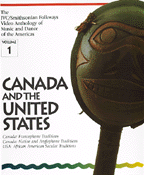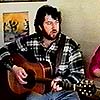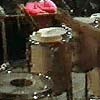EOL video review The JVC/Smithsonian Folkways |
|
| 1. Canada
and the United States: Secular Traditions Producer: The Victor Company of Japan, Ltd., Director:HIROAKI OHTA, Co-Producer: STEPHEN McARTHUR, Associate Producer: HIROSHI YOSHIDA, Executive Producers: KATSUMORI ICHIKAWA & YUJI ICHIHASHI. Video/color, 59:18 (this tape). Editorial supervisor (books): TOMOAKI FUJI, Senior Editor: ANTHONY SEEGER, Editor (books): MARK GREENBERG. Booklet notes (this volume) by Beverly Diamond, LeeEllen Friedland, André Gladu, Mark Greenberg, Lisa Ornstein, Charles Sykes, and Robert Witmer. 1995. Distributors: Multicultural Media, RR 3, Box 6655, Granger Road, Barre, Vermont 05641 USA, and Smithsonian Folkways, 955 L'Enfant Plaza, suite 7300, Washington DC 20560 |
|
Canada: Francophone Traditions Two-thirds of this video are dedicated to the music, song, and dance of Canada. The first portion of the Canadian section, Music and Dance of Francophone Canada, focuses on the traditions associated with the French-speaking population of Québec, Acadian New Brunswick, Nova Scotia, and Newfoundland. The video footage, while dated, provides wonderful examples of dance and musical traditions alike. Most of the footage was recorded in the mid- to late-seventies. One might be tempted to think that these traditions no longer carry on when in fact, twenty years later, they are still an integral part of the culture in many regions of Canada. In addition, the liner notes included in the booklet that accompany the video give a fine explanation of the individual selections and performers, when possible, and includes suggestions for further listening, viewing, and reading.
|
|
"St. Anne's Reel" 160x120, 8 sec, 900K QuickTime |
Especially welcome in this survey are two examples of turlute,
or lilting. In communities where musical instruments were not available, turlute was a
common dance accompaniment. The popularity and availability of musical instruments has
made lilting a rare art. Video 1-8 showcases Audrey St-Coeur of Néguac,
New Brunswick performing "St. Anne's Reel" in the reel à bouche (reel of
the mouth) tradition. Notice the percussive foot-stamping, a common aspect of the
traditional Québecois and Acadian musician. The chansons strophiques are the most characteristic type of Acadian traditional song. In this clip Lazare Hébert, also from Néguac, performs the story-telling song "Écoutez-moi, je vas vous chanter un p'tit tour qui m'est arrivé," a comedic tale of a blind date gone wrong.
|
Canada: Native and Anglophone Traditions The second portion of the Canada section is Native, Anglophone, and Other Canadian Music and Dance. This is quite a broad categorization and really only four groups are represented: Inuit, Cree, Métis, and Anglophone maritimers. Canada has seen a great influx of immigrants from many different countries and it would be impossible to include examples from them all on this video. However I do feel that a broader base of examples could have been employed. Ukranian, Chinese, Vietnamese, Middle Eastern and Greek communities, to name but a few, are in abundance in cities all over Canada and the cultural traditions that they continue add greatly to Canada's overall cultural heritage. The traditions that are featured on this video are extremely accurate representations and I feel that the addition of further cultural examples would be very welcome. Again, the liner notes give background information on the selections and performers as well as providing other references to gain more information on the different styles of music and dance showcased in this section of the video. |
|
"Inuit Katajjait" 160x120, 8 sec, 830K QuickTime 320x240, 19 sec, 4MB QuickTime
|
The first example in this section is Video 1-12, "Inuit Katajjait" (vocal games). This technique is sometimes referred to as throat singing in English. These games "involve an interchange between two women who face one another and exchange syllables or short phrases of vocables" such as "hamma", "hapapa" and "mugula". |
"Lukey's Boat" 160x120, 8 sec, 830K QuickTime 320x240, 19 sec, 4MB QuickTime
|
A traditional song type from the Maritimes is the sea shanty.
The majority of Newfoundlanders are of Irish descent and their music, both traditional and
contemporary, depicts this ancestry. Video 1-17, recorded in 1994, features Rik
Barron and Dave Panting of St. John's, Newfoundland performing "Lukey's Boat."
This style of song and performance is popular in communities all over Canada, not
just in the Maritimes.
|
| Canadians regularly refer to their country as a
"cultural mosaic" as opposed to the United States' "melting pot." From
a very young age, Canadian school children are introduced to a multitude of cultural
traditions that have helped shape Canada into this mosaic. The Canadian government and
society in general makes a great effort to ensure that traditions from many cultures are
preserved and carried on, becoming a part of the Canadian identity. This video overview is
a wonderful showcase for many of the music and dance traditions that are integral aspects
of the Canadian cultural mosaic. reviewed by Karen McGale
|
|
| USA: African American Secular Traditions One of the biggest problems with any anthology produced for ethnographic purposes is the issue of selection: Just what should represent a tradition? How should genres be proportionately represented? The JVC/Smithsonian anthology is no exception. This collection of secular music from the African American tradition, mostly recorded between the late seventies and early nineties, is a fairly diverse representation of "vernacular" expressions. The fourteen brief excerpts and short song selections, from 1:20 to 3:10 minutes each, are weighed most heavily toward the blues; five of the selections represent this genre, more than any other. If this anthology is used as a general means of acquainting oneself with African American traditions, one may leave with the wrong assumption that secular "non-popular" traditions ended with the blues, with little developed past the 1950s worthy of representation in a scholarly anthology. The collection includes regional styles, such as Piedmont guitar finger picking, a Mardi Gras Indian song, and New Orleans brass music. Unfortunately, only two non-blues selections represent styles that emerged from urban areas since the fifties. The legendary Orioles performing rhythm and blues influenced by gospel quartets, and the Junkyard Band, an ensemble consisting of youths performing funk-influenced go-go music from Washington, D.C. Anthony Seeger, in the notes accompanying the collection, writes: "Although we have not excluded all forms of popular music in the hemisphere, our primary focus is on vernacular styles. Music television (MTV) and the commercial media are amply reproduced in commercial media. Instead, we have concentrated on performances in local communities by people playing, dancing, laughing, celebrating, and worshiping." (p.4). It may be true that inclusion of more popular and commercialized styles, such as rap music, are amply represented in commercial media. However, as the notes by Barbara Hampton and Charles Sykes correctly state, "rap [music] stands at the forefront of African American popular music in the 1990s... Reflecting an African-derived oral tradition, rap lyrics provide narrative commentary on people, events, and situations" (p. 53). Any video anthology of African American secular music compiled in the nineties is incomplete without the inclusion of the verbal-musical traditions of rap music or its roots: this could include any of the numerous public presentations of both staged and informal musical events related to rap music or its wider cultural expression known as "hip-hop." Competitive male-oriented dancing, known as b-boying or breakdancing; recreational, verbal dueling, or "playing the dozens;" or the spontaneous rapping on street corners in a tight circular formation, known as a"cipher" could have provided viewers with the often discussed, but little visually represented, connection of rap music to its broader cultural connections. Rap music is presented as a vital part of black musical traditions only in the notes.
|
|
"The Junkyard Band" 160x120, 8 sec, 830K QuickTime |
Regional contemporary styles developed by and for youths are
represented in the go-go excerpt, performed by the local ensemble, The Junkyard Band
(video 1-32). Unfortunately, this presentation is slighted by both its placement in
the video, and the brevity of the example relative to the selections that precede it. This video excerpt was quite obviously a "field recording" in a crowded dance hall. The sound quality is understandably not as clear as the professional clips preceding it, and the sound is distorted due to the extremely high volume of the amplified microphone and instruments.
|
Some of the jarring effects of this example could have been softened by placing it immediately after another live recording. However, the go-go piece directly follows the smooth, a cappella vocals of The Legendary Orioles. Thematically, this pairing works, in that these last two pieces represent the fine line between "vernacular" and "popular" traditions. Aesthetically, the sequence does not succeed. By the time one's ear adjusts to the final example, the piece ends abruptly and the video credits roll, giving little time to digest the combination that may initially be considered odd for inclusion in a collection of "vernacular" traditions since it blends audience and musician interaction with: an emcee at the microphone, a prominent percussion ensemble, synthesizers, and a spontaneous dancer. With all of these musical elements present in the go-go example there is a need to contextualize its different elements. It is one of the shortest examples, and raises questions unanswered in the notes or on-screen. Why, for instance, was an amplified, popular local group chosen to represent this music, rather than one that uses paint buckets? The juxtaposition (or co-existence) of amplified, synthesized instruments with live, analog percussion is characteristic of go-go music. Congas and timbales (or their electronically-reproduced equivalents) are not characteristic of contemporary African American urban music that is not directly Latin-derived, but are typical of go-go ensembles. Even thirty additional seconds would have given the viewer the opportunity to adjust to and appreciate the different elements of this go-go example. What the anthology does document quite well is the various blues traditions from country "Piedmont" guitar picking to Chicago style urban styles. One of the most effective excerpts underscores the fine line between the secular and the sacred in African American music features the Rev. D.A."Gatemouth" Moors making a guest appearance on stage at a blues performance by Rufus Thomas. The guitar-accompanied vocal performance by Elizabeth "Libby" Cotton shows that guitar traditions are neither limited to the blues, nor to male musicians as they are commonly presented. Although the participation of musician and composer Danny Barker singing "Save the Bones for Henry Jones" is classified as a "popular song with traditional jazz combo," the song has been utilized more often as a jazz standard having been recorded by Ray Charles and Sammy Davis, Jr. The "popular song" description more accurately applies to the song form, rather than to the genre. The descriptive notes suggest this distinction, but do not state it clearly. The notes by Hampton and Sykes are quite useful, and, as I suggest above, provide a more inclusive picture of African American music than does the video. The "Overview" gives basic historical and stylistic descriptions and includes a discussion of the close relationship between secular and the sacred music. The section that follows it, "African American Secular Music" (Sykes), opens with a problematic statement: "African American secular music can be generally divided into 'jazz' and 'non-jazz' traditions (p. 50). This demarcation appears to be arbitrary and no more definitive than any other. For the purposes of the video collection, one could argue that a distinction between "blues" and "non-blues" or "commercial/popular" and "non-commercial/popular" traditions would be better. Soon after the opening sentence, however, Sykes qualifies the distinction, correctly, emphasizing that "any attempt to characterize music or musicians must be taken as a generalization" (p. 50). Overall, the effectiveness of the video anthology could have been improved by reordering the excerpts by genre and/or instrumentation, and by a more even representation of contemporary musical styles. Such styles would include "roots" of rap and examples of rapping -- such as children's games, poetry, and dance. As the anthology exists, however, it does not give a sufficiently broad picture of the diversity of styles expressed across different age groups. Aside from the go-go excerpt, the only musical expressions from youthful groups were recorded in 1976 ("Children's Ring Game") and the 1986 (Rebirth Brass Band). The anthology perpetuates the old notion that the best of what people have to offer happened long ago. reviewed by Dawn Norfleet |
|




